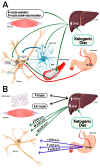Satiating Effect of a Ketogenic Diet and Its Impact on Muscle Improvement and Oxidation State in Multiple Sclerosis Patients
- PMID: 31126118
- PMCID: PMC6566517
- DOI: 10.3390/nu11051156
Satiating Effect of a Ketogenic Diet and Its Impact on Muscle Improvement and Oxidation State in Multiple Sclerosis Patients
Abstract
Background: It was previously established that Multiple sclerosis (MS) generates energy alterations at the mitochondrial level related to the loss of muscle mass. Ketone bodies, mainly beta-hydroxybutyrate (BHB), re-establish this energy alteration causing satiety, changes in body composition and a decrease in hormone-dependant hunger, such as ghrelin. The aim of this study was to establish possible improvements in body composition and the level of oxidation in patients with MS, by means of the satiating effect of a ketogenic diet.
Methods: A pilot study was carried out with 27 MS patients who were given a Mediterranean isocaloric and ketogenic diet for 4 months. Anthropometric measurements, as well as satiety and hunger perception (VAS scale), were taken. In addition, BHB and paraoxonase 1 (PON1), as an oxidation marker, were measured by spectrophotometric automated assays, and ghrelin was determined by an enzyme immunoassay in the serum. All measurements were taken before and after the intervention.
Results: A significant increase in satiety perception at lunch and dinner and of BHB in the blood was obtained. Hunger perception decreased significantly at lunch and dinner with similar levels of ghrelin. In addition, an important increase in lean mass and PON1 was observed. To our knowledge, this is the first study addressing improvements in body composition, oxidation state and metabolism in MS patients, based on the satiating effect of a Mediterranean isocaloric diet.
Conclusion: A ketogenic diet increases lean mass and decreases inflammation and oxidation possibly as a consequence of an increase in satiety and decrease in hunger in MS patients.
Keywords: ghrelin; ketogenic diet; multiple sclerosis; paraoxonase 1; satiety; β-hydroxybutyrate.
Conflict of interest statement
The authors declare no conflict of interest.
Figures


Comment in
-
When is a Ketogenic Diet Ketogenic? Comment on "Satiating Effect of a Ketogenic Diet and Its Impact on Muscle Improvement and Oxidation State in Multiple Sclerosis Patients, Nutrients 2019, 11, 1156".Nutrients. 2019 Aug 15;11(8):1909. doi: 10.3390/nu11081909. Nutrients. 2019. PMID: 31443214 Free PMC article.
Similar articles
-
When is a Ketogenic Diet Ketogenic? Comment on "Satiating Effect of a Ketogenic Diet and Its Impact on Muscle Improvement and Oxidation State in Multiple Sclerosis Patients, Nutrients 2019, 11, 1156".Nutrients. 2019 Aug 15;11(8):1909. doi: 10.3390/nu11081909. Nutrients. 2019. PMID: 31443214 Free PMC article.
-
The Impact of Coconut Oil and Epigallocatechin Gallate on the Levels of IL-6, Anxiety and Disability in Multiple Sclerosis Patients.Nutrients. 2020 Jan 23;12(2):305. doi: 10.3390/nu12020305. Nutrients. 2020. PMID: 31979305 Free PMC article. Clinical Trial.
-
Possible Reduction of Cardiac Risk after Supplementation with Epigallocatechin Gallate and Increase of Ketone Bodies in the Blood in Patients with Multiple Sclerosis. A Pilot Study.Nutrients. 2020 Dec 10;12(12):3792. doi: 10.3390/nu12123792. Nutrients. 2020. PMID: 33322022 Free PMC article. Clinical Trial.
-
Impact of ketosis on appetite regulation-a review.Nutr Res. 2020 May;77:1-11. doi: 10.1016/j.nutres.2020.02.010. Epub 2020 Feb 20. Nutr Res. 2020. PMID: 32193016 Review.
-
Ketogenic diets and appetite regulation.Curr Opin Clin Nutr Metab Care. 2021 Jul 1;24(4):359-363. doi: 10.1097/MCO.0000000000000760. Curr Opin Clin Nutr Metab Care. 2021. PMID: 33883420 Review.
Cited by
-
Effect of the Mediterranean diet supplemented with nicotinamide riboside and pterostilbene and/or coconut oil on anthropometric variables in amyotrophic lateral sclerosis. A pilot study.Front Nutr. 2023 Sep 22;10:1232184. doi: 10.3389/fnut.2023.1232184. eCollection 2023. Front Nutr. 2023. PMID: 37810917 Free PMC article.
-
Ketogenic Diet: An Effective Treatment Approach for Neurodegenerative Diseases.Curr Neuropharmacol. 2022 Nov 15;20(12):2303-2319. doi: 10.2174/1570159X20666220830102628. Curr Neuropharmacol. 2022. PMID: 36043794 Free PMC article. Review.
-
When is a Ketogenic Diet Ketogenic? Comment on "Satiating Effect of a Ketogenic Diet and Its Impact on Muscle Improvement and Oxidation State in Multiple Sclerosis Patients, Nutrients 2019, 11, 1156".Nutrients. 2019 Aug 15;11(8):1909. doi: 10.3390/nu11081909. Nutrients. 2019. PMID: 31443214 Free PMC article.
-
[Aspects of nutrition for prevention and treatment of chronic neurological diseases].Nervenarzt. 2019 Aug;90(8):843-857. doi: 10.1007/s00115-019-0756-9. Nervenarzt. 2019. PMID: 31375848 German.
-
Exploring the impact of ketogenic diet on multiple sclerosis: obesity, anxiety, depression, and the glutamate system.Front Nutr. 2023 Aug 25;10:1227431. doi: 10.3389/fnut.2023.1227431. eCollection 2023. Front Nutr. 2023. PMID: 37693246 Free PMC article. Review.
References
MeSH terms
Substances
Grants and funding
LinkOut - more resources
Full Text Sources
Miscellaneous

